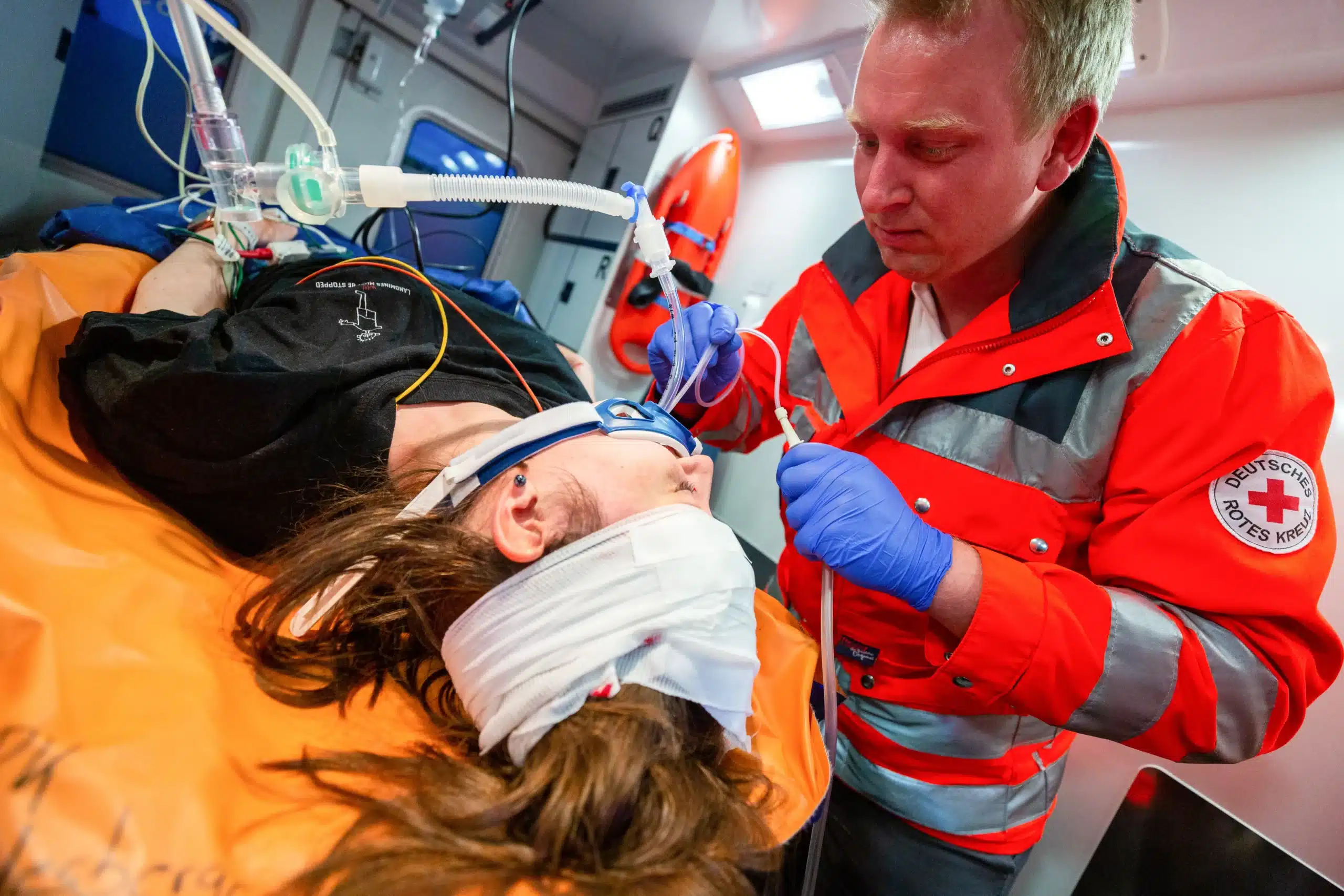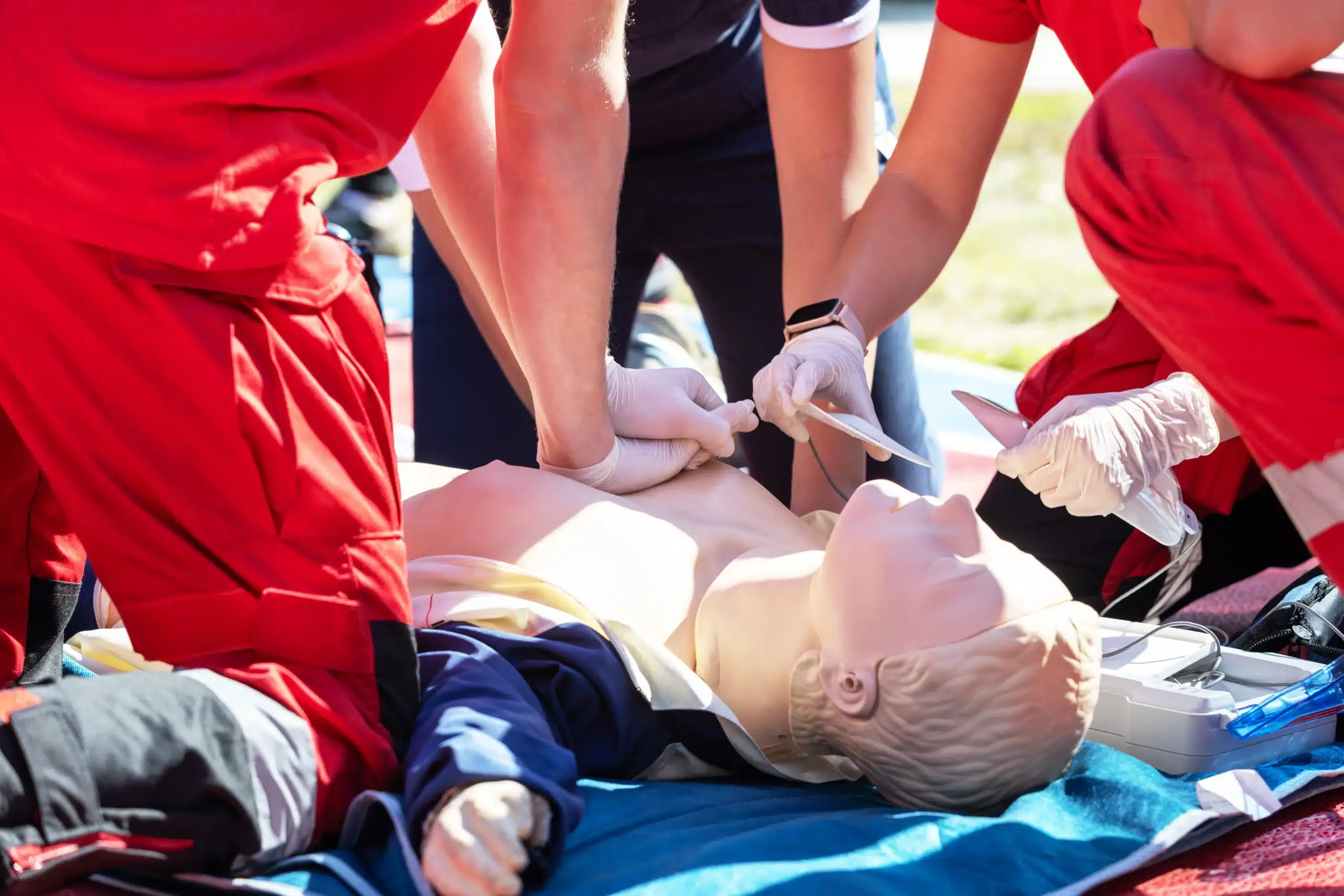Balancing the demands of a healthcare career with continuing education can be tough. That’s why the flexibility of PALS HeartCode is so valuable. This blended learning program from the American Heart Association allows you to complete the online portion of your PALS certification at your own pace, fitting it around your busy schedule. But what exactly is PALS HeartCode, and how does it work? In this article, we’ll cover everything you need to know, from the curriculum and skills you’ll learn to the costs and benefits of this innovative approach. We’ll also explore how PALS HeartCode compares to traditional PALS training and provide a step-by-step guide to getting certified. Discover how you can gain the confidence and skills to handle pediatric emergencies effectively with the convenience of PALS HeartCode.
Key Takeaways
- HeartCode® PALS blends online learning with hands-on practice: This flexible format lets you learn the material at your own speed online, then demonstrate your skills in a separate in-person session.
- Adaptive technology personalizes your learning experience: The online modules adjust to your progress and understanding, providing extra support in areas where you need it most.
- PALS certification equips you with essential skills: You’ll learn to perform high-quality CPR, manage pediatric emergencies, and work effectively as part of a team.
What is HeartCode® PALS?
HeartCode® PALS is a blended learning program from the American Heart Association (AHA) that teaches healthcare providers the critical skills needed to respond to life-threatening emergencies in infants and children. It combines online learning with a hands-on skills session, culminating in your PALS certification. This approach allows you to learn at your own pace online, then demonstrate your skills in person.
Definition and Purpose
PALS stands for Pediatric Advanced Life Support. The HeartCode® PALS course uses a combination of eLearning modules and in-person practice to build your expertise in pediatric emergency care. The program focuses on recognizing and preventing cardiopulmonary arrest in children, equipping you with the knowledge and skills to intervene effectively. You’ll learn to assess a child’s condition quickly, administer appropriate interventions, and work as part of a team during a crisis. This preparation is essential for any healthcare provider working with young patients. You can find more information on the AHA website.
How Blended Learning Works
The advantage of HeartCode® PALS lies in its flexible, blended learning design. You begin with interactive online modules, working through case studies, simulations, and self-directed learning activities. This online portion allows you to learn the core concepts and practice decision-making at your own speed. Once you’ve completed the online component, you’ll schedule a separate in-person skills session with an AHA Instructor. This session focuses on hands-on practice and evaluation of the skills you learned online. Both parts—online and in-person—are required to receive your PALS certification.
HeartCode® PALS vs. Traditional PALS
While the delivery method differs, the content and rigor of HeartCode® PALS align with the AHA’s traditional PALS course. Both courses adhere to the same AHA guidelines and lead to the same recognized certification. The key difference is the flexibility offered by the blended learning format of HeartCode® PALS. It allows you to fit the training into your busy schedule more easily, completing the online portion when and where it suits you best. This makes HeartCode® PALS a particularly attractive option for those juggling work, family, and other commitments. If you’re looking for PALS certification in Sacramento, check out Safety Training Seminars.
HeartCode® PALS: Curriculum and Skills
This section covers what you’ll learn in a HeartCode® PALS course and how it prepares you for real-world pediatric emergencies.
Key Topics Covered
The HeartCode® PALS course from the American Heart Association equips healthcare providers with essential skills and knowledge for managing pediatric emergencies. The curriculum covers high-quality CPR techniques, recognizing and treating emergencies like respiratory distress and shock, and building effective team dynamics. It also covers post-arrest management, ensuring you’re prepared for a range of scenarios.
Learn High-Quality CPR
High-quality CPR is a core component of the HeartCode® PALS course. You’ll learn the latest techniques and guidelines for performing effective CPR on pediatric patients, a skill crucial for improving survival rates. For more in-depth CPR training, check out our BLS course.
Recognize and Treat Pediatric Emergencies
The HeartCode® PALS curriculum covers a wide range of pediatric emergencies. You’ll learn to recognize and treat respiratory and shock emergencies, plus learn about dysrhythmias. This comprehensive training prepares you to handle various critical situations.
Improve Team Dynamics and Communication
Effective teamwork and communication are vital during emergencies. The HeartCode® PALS course emphasizes the importance of a systematic approach to pediatric assessment and highlights the power of teamwork in successful resuscitation. You’ll learn how to communicate effectively within a team to improve patient outcomes. Central Valley Medical offers further insights into team dynamics in PALS training.
How Adaptive Learning Technology Helps
The online portion of HeartCode® PALS uses adaptive learning technology, personalizing your learning experience based on your performance and confidence levels. This ensures you thoroughly understand the material and are well-prepared for the skills assessment. Learn more about the blended learning format of HeartCode PALS on the AHA website.
Get Certified in HeartCode® PALS
Complete the Online Portion
HeartCode® PALS is a blended learning course from the American Heart Association (AHA) designed for healthcare providers needing Pediatric Advanced Life Support (PALS) certification. This program combines online learning with a separate, in-person skills session (sold separately). You’ll need to complete both portions to earn your PALS certification. The online portion lets you learn at your own pace and review material as needed.
Attend the In-Person Skills Session
After finishing the online modules, you’ll attend an in-person skills session with an AHA instructor. This session isn’t included with the online portion, and you’re responsible for finding and scheduling this instructor-led training. Check with your employer, local hospitals, or training centers like Safety Training Seminars for available sessions. This hands-on component is crucial for mastering practical skills needed in real-life emergencies.
Get Evaluated by an AHA Instructor
During the in-person skills session, an AHA instructor will evaluate your skills and knowledge. They’ll observe your performance of critical skills like high-quality CPR, effective ventilation techniques, and appropriate responses to pediatric emergencies. This evaluation ensures you meet the AHA’s standards for PALS certification. The HeartCode® PALS course offers continuing education credits for various healthcare professionals, including physicians, physician assistants, nurse practitioners, nurses, pharmacists, emergency medical services personnel, and respiratory therapists.
Certification Validity and Renewal
Once you successfully complete both the online and hands-on components, you’ll receive your AHA PALS Provider card, valid for two years. To maintain your certification, you’ll need to retake the PALS course before it expires. Keep track of your renewal date to ensure continuous compliance and maintain your skills. You can find PALS renewal information on the AHA website.
Cost and Value of HeartCode® PALS
Investing in high-quality PALS training is essential for any healthcare provider committed to delivering the best possible emergency care for children. Let’s break down the costs associated with HeartCode® PALS and explore why it’s a worthwhile investment.
Pricing
The HeartCode® PALS course typically costs around $185. This fee covers the online portion of the training, which usually takes between six and nine hours to complete. Remember that this online component is just the first step. You’ll also need to complete an in-person skills session, which typically adds another $75-$150 to the total cost, depending on the provider. Check with your chosen training center for their combined online and in-person pricing, as some centers may offer package deals. At Safety Training Seminars, we strive to keep our pricing competitive and offer the lowest prices in Sacramento County with our low price guarantee.
Discounts and Promotions
If you’re coordinating training for a group, look for discounts. Many training centers, including Safety Training Seminars, offer reduced rates for group registrations and bulk purchases. The American Heart Association often has promotions on their HeartCode® PALS courses with increasing savings for larger purchases. These discounts can significantly lower the per-person cost, making training your entire team more affordable. Contact us directly to discuss group discounts and find a solution that fits your budget.
Return on Investment for Healthcare Providers
The value of HeartCode® PALS goes beyond the initial cost. This training equips healthcare providers with the skills and knowledge to manage pediatric emergencies confidently. The course uses adaptive learning technology, personalizing the experience to each student’s learning pace and style. This approach improves knowledge retention and makes the training more efficient. Completing both the online and in-person components earns you an American Heart Association (AHA) PALS Provider card, valid for two years. This nationally recognized certification demonstrates your commitment to providing high-quality care, potentially leading to better patient outcomes and increased team confidence. For healthcare organizations, investing in PALS training is an investment in the future, ensuring your team is prepared for critical situations.
Benefits of HeartCode® PALS
HeartCode® PALS offers several advantages for healthcare providers seeking certification. The blended learning format combines online learning with in-person skills practice, creating a flexible and efficient path to mastering pediatric advanced life support techniques. Let’s explore some key benefits:
Flexibility and Convenience
Juggling work, family, and continuing education can be challenging. HeartCode PALS recognizes this and offers a flexible learning solution. The online portion allows you to learn at your own pace, anytime, anywhere. This blended learning format lets you complete online modules when it’s convenient for you, then demonstrate your skills in a hands-on session. This flexibility eliminates the need to take multiple days off work or arrange complicated childcare. You can study during your commute, on lunch breaks, or even late at night—whatever fits your schedule.
Personalized Learning
HeartCode PALS uses adaptive learning technology. This personalized approach focuses your learning experience on areas where you need the most practice. The program assesses your understanding as you progress and tailors the content accordingly. If you’re struggling with a particular concept, the system provides additional resources and practice opportunities. Conversely, if you quickly grasp a topic, you can move on to the next module without unnecessary repetition. This personalized learning path ensures you get the most out of the program and build a solid foundation in PALS principles.
Real-Time Feedback and Skills Assessment
The online modules use eSimulations and case studies to make learning more engaging and promote better knowledge retention. These interactive scenarios provide opportunities to apply your knowledge in realistic virtual environments. You’ll receive immediate feedback on your decisions, helping you identify areas for improvement and reinforce correct techniques. This real-time feedback is invaluable for building confidence and preparing for the in-person skills session. The online portion also includes assessments to gauge your understanding of the material and track your progress. Learn more about PALS HeartCode.
Save Time and Resources
HeartCode PALS can be more time-efficient than traditional classroom-based courses. By completing the online modules at your own pace, you can focus on the areas where you need the most practice. This targeted approach can significantly reduce the overall time commitment compared to a fixed-schedule course. Plus, the blended learning format of HeartCode PALS often translates to cost savings. While pricing varies, the online portion can sometimes be more affordable than traditional courses. Check our low price guarantee.
Access the PALS Provider Manual eBook
With HeartCode PALS, you’ll receive access to the PALS Provider Manual eBook. This digital resource provides comprehensive information on pediatric advanced life support guidelines and procedures. You can access the eBook on your computer, tablet, or smartphone, making it easy to review key concepts and refresh your knowledge anytime, anywhere. The PALS HeartCode course provides healthcare providers with the essential knowledge and skills to manage pediatric emergencies effectively. Having the eBook readily available is a valuable tool for ongoing learning and reference.
Get Started with HeartCode® PALS
So, you’re ready to get your PALS certification or recertification—fantastic! HeartCode PALS is a great option, offering flexibility and a personalized learning experience. Here’s how to get started:
Enroll in HeartCode® PALS
First, enroll in the online portion of the HeartCode PALS course. You can find this through the American Heart Association website. Once you’ve registered, you’ll have access to all the course materials and learning modules.
Prepare for the Online Portion
This part of the course uses adaptive learning technology, meaning it adjusts to your pace and understanding as you progress. If you find some areas more challenging than others, don’t worry! The program will give you the extra practice you need. Make sure you have a reliable internet connection and a quiet space where you can focus. Treat it like any other important course, and set aside dedicated time for learning.
Schedule Your In-Person Skills Session
After completing the online portion, schedule an in-person skills session. This is a crucial step because it allows you to demonstrate your skills and receive feedback from a certified AHA instructor. Safety Training Seminars offers these sessions, making it easy to complete your certification.
Tips for Success
The beauty of HeartCode PALS is its blended learning approach. Take advantage of the online portion’s flexibility to learn at your own speed. Don’t rush through the material—take your time to absorb the information. When you attend the in-person skills session, be prepared to ask questions and actively participate. This hands-on practice is essential for building confidence and solidifying your skills.
HeartCode® PALS Providers
Several organizations offer HeartCode PALS training, giving you options to choose from:
American Heart Association
The AHA developed HeartCode PALS, so their website is an excellent resource for information and course registration.
Safety Training Seminars
Safety Training Seminars provides both the online portion and the required in-person skills sessions, making it a convenient option for all your PALS certification needs.
Central Valley Medical
Central Valley Medical also offers HeartCode PALS training. Visit their website for course schedules and availability.
Children’s Hospital of Philadelphia
CHOP offers the HeartCode PALS program, with a focus on giving healthcare providers the skills to respond to pediatric emergencies.
Related Articles
- HeartCode PALS: Your Guide to Online Certification – Sacramento CPR Classes
- PALS Classes in Sacramento, CA – Sacramento CPR Classes
- Pediatric Advanced Life Support (PALS) in Sacramento – Sacramento CPR Classes
- Online CPR Classes in Sacramento: Your Complete Guide – Sacramento CPR Classes
- Online PALS Classes in Sacramento: Your Guide – Sacramento CPR Classes
Frequently Asked Questions
What is the difference between HeartCode® PALS and traditional PALS? Both HeartCode® PALS and traditional PALS follow the same American Heart Association guidelines and result in the same certification. The main difference lies in the format. HeartCode® PALS uses a blended learning approach, combining online modules with an in-person skills session, while traditional PALS is entirely classroom-based. This blended format offers greater flexibility for scheduling.
How long does it take to complete the HeartCode® PALS course? The online portion of HeartCode® PALS typically takes between six and nine hours to complete, though the self-paced nature allows you to spread this out as needed. The in-person skills session is a separate event, usually lasting a few hours, depending on the training center.
Where can I find an in-person skills session after completing the online modules? Several organizations offer the in-person skills session required to complete your HeartCode® PALS certification. Safety Training Seminars, local hospitals, and other training centers often provide these sessions. Check with your employer or search online for AHA-authorized training centers in your area.
How much does HeartCode® PALS cost? The cost of HeartCode® PALS varies, with the online portion typically costing around $185. The in-person skills session is an additional fee, usually between $75 and $150. Some training centers offer combined packages for both portions, so it’s best to check with your chosen provider for their specific pricing. Safety Training Seminars offers a low price guarantee for their courses.
How long is my PALS certification valid, and how do I renew it? Your PALS certification is valid for two years. To renew, you’ll need to retake the PALS course before your current certification expires. You can find information on renewal courses through the American Heart Association or your original training provider.








